New York's Most Bonkers Boulevard!
Plus! Barbie vs. Oppenheimer!! The Deal With Your Goodwill Donations!!!
Hello everyone,
Welcome to Issue #83 of CAFÉ ANNE!
I try to avoid the movies as much as possible, but last week I got all caught up in this Barbie/Oppenheimer thing and saw both! Look at me, being all current on pop culture!
I loved Barbie. It was a super-fun experience—hilarious and ridiculous from start to finish.
As for its rival…you know how many movie trailers feature a series of 10-second clips, each scene at a fever-pitch, accompanied by a thunderous, panic-stricken soundtrack and melodramatic dialogue? Imagine that blasting for three hours straight and you’ve got Oppenheimer. I was laughing at, not with, this overblown absurdity. Around the 90-minute mark, I started checking my watch and wondering if I could convince my friend to leave early.
This was a surprise. I expected to love Oppenheimer and get bored with Barbie! So now I’m wondering: are CAFÉ ANNE readers a Barbie crowd or an Oppenheimer gang? Survey time!
Please vote! I’d also love to read your mini review of either movie in the comments.
In other news, atomic-bomb shoutouts to this week’s new paid subscribers S. Mshanetskiy, L. Zibulsky, A.C. Beyer, Julie D., Ruslana, Janice S., and Joyce B. That’s enough $$$ for me to see Oppenheimer 22 times—though in truth, you could not pay me to watch it again.
I am very excited about this week’s issue, of course. We’ve got the latest edition of ASK CAFÉ ANNE. There’s also an account of my recent trip to Avenue U in Brooklyn—New York’s most bonkers boulevard. Please enjoy.
Regards!
Anne
ASK CAFÉ ANNE
What Happens To My Goodwill Donation?
Dear CAFÉ ANNE,
This weekend we hauled some old junk from my mother's house to Goodwill. We dropped off clothes, trophies, a humidifier and a large Tupperware platter.
Here's what we wondered: how often do the staff at Goodwill throw away the donations? And what do they toss out? What are memorable items that were deemed "not up to Goodwill standards"?
I hope CAFÉ ANNE can find the answers (while also picking up some good tips of what are some good reselling items).
—Kevin in NY
Dear Kevin,
Great question! I often wonder, when cleaning out my closet, if my donations are up to snuff. I'm pretty sure that used underwear is not cool. But what about used candles? What about antlers?
To find out, I got on the phone with Ilana Zimmerman. She's the Executive VP of Donated Goods, Retail for Goodwill NY/NJ. It's a big job. Ms. Zimmerman oversees nearly 30 stores, donation centers and outlets in the area with $50 million in annual sales. It all goes to support the Goodwill NY/NJ mission of job training and placement for folks who have trouble getting work because they have a disability, for example, or don't speak English.
I started by asking Ms. Zimmerman how much is donated. The answer: roughly one million donors drop 39 million pounds of stuff every year. According to ChatGPT, that’s equivalent to the weight of 2,815 elephants, or 975 truckloads—and could fill a warehouse covering several city blocks.
So what percentage does the staff discard? Pretty much zero. "We really sell everything—artwork, air fryers. It's a daily treasure hunt for our shoppers," said Ms. Zimmerman.
When people drop donations, she added, there’s typically an attendant overseeing the process.
"Someone's watching, so there's sort of a shame factor involved," I observed.
"We don't go there," said Ms. Zimmerman. "We appreciate every donation!"
But not every donation hits the store floor. Jewelry, designer clothing and other high-value items are sent to the Goodwill NY/NJ warehouse in Hackensack, NJ and sold online through shopgoodwill.com, accounting for 8% of retail sales.
A look at the site’s "miscellaneous" section, by the way, provides an idea of what Goodwill will accept. Among the items:
- "Long Hair Black and Green Cosplay Wig"
-"Grab Bag of 3 Deer Antlers"
-"Redding Gun Club Patch"
-"Horse Collar W/Brass Toppers Tack Mule Yoke"
-"Lot of Random Fabric"
The rest of the merchandise hits the store shelves, says Ms. Zimmerman. Most donations sell in a few weeks while housewares typically sell within days. Store sales account for about 75% of retail revenue, she said.
Everything that fails to sell within roughly a month is shipped to Goodwill’s two outlet stores in Queens and South Hackensack.
There, shoppers buy merchandise by the pound. Housewares cost $1.39 a pound, clothing costs $1.99-$2.29. Shoes and accessories are the priciest category, selling for $2.09-$2.39 a pound. The outlets account for 17% of retail sales.
"And if it doesn't sell there, does it finally hit the trash?" I asked.
Nope! There are recycling and bulk buying companies, said Ms. Zimmerman, that will happily purchase whatever doesn't sell at the outlet.
So there you go, Kevin. Your mom's trash is now definitely someone's treasure—especially the large Tupperware platter.
Have a NYC question for ASK CAFÉ ANNE? Email annekadet@yahoo.com.
FEATURE
New York’s Most Bonkers Boulevard!
They say America is a melting pot. But in NYC, it's typically more of a salad, with all the ingredients remaining distinct. This is nowhere more true than Avenue U in Brooklyn—my favorite retail strip in the city.
Here, the original mix of Jewish and Italian storefronts has been gradually supplanted by shopkeepers from China and the former Soviet Union, and there is zero melting happening. As a scene, it makes no sense, which is great. Even better, many of the businesses simply defy logic.
Last week, I spent the day wandering the entire 2.5-mile strip—which runs through Gravesend and Sheepshead Bay—chatting to shop owners, snapping photos and eating donuts. I had such a good time, and hope you do too!
Starting my journey at the avenue’s west end, I was delighted to spot a new storefront: Runway 187. Someone had created a little sidewalk lounge out front featuring chairs shaped like a human hands. Smoke shops are common these days, but this makeshift sidewalk lounge—surrounded by velvet ropes!–was a first.
John, the clerk on duty, came out to say hello and welcomed me into the shop.
"Ever since weed became legal, everyone's just trying to open up a smoke shop ‘cuz it's lucrative," said John. "Especially in New York. I would say more than 50% of the people in New York smoke."
"It's everywhere now," he continued, lighting up. "It's just absurd. I see people rolling joints on the train, on the busses. They're smoking in front of cops. It's crazy. I never thought I'd see the day. Listen, I'm 41. I remember back in my twenties, man, I got arrested for smoking weed. I remember going to jail three, four times a month just for smoking weed."
"Wow," I said, "You must have really liked weed."
Runway is dedicated entirely to CBD and THC products including edibles—plus anything you might need to support your habit.
"Lighters, ashtrays, we even sold tasers," he said. "To girls! The girl tasers! Yeah. Girls were buying them too."
"What makes a taser a girl taser?" I asked.
"It was pink! The taser was pink," said John. "It was cool though—we sold a lot of them."
John said he enjoys the mix of ethnicities on Avenue U. He grew up in Brighton Beach, "So my whole life I've been around Mexicans, Russians, Filipinos, Pakistanis," he said. "I'm Filipino. Name any nationality, I have a friend that's from there. Which is cool. I like that."
I asked about the sidewalk lounge. The owner created it, said John, so folks could hang out and enjoy whatever they bought in the store.
I asked if he offered waiter service.
"Imagine having to waiter?" he said. "Bring stuff outside? That's next level. Yeah, that's next level."
It had been two years since my last visit to Avenue U and I was happy to see little had changed. Many businesses are still simply named after the product or service they offer: "Medical Office," "Computer Store," "Dry Cleaner," "Meat Market." There were several businesses named "Laundrymat."
Shop monikers incorporating the avenue's name are also common. I spotted "Healthier U" (nutrition and chiropractic), "Sparkle On U" (nail salon), "U Ship" (for package delivery) and my favorite, the produce shop "Banana King on U."
My second stop: Boutique Butcher New York (“Quality Meats Perfection”), a Kosher meat market. Inside, I was confronted with a solid brass wall featuring the shop's name in neon. The interior was gleaming white marble, lit by space-age chandeliers; dance music thumped in the background. An elegant ensemble of chrome-and-white-leather lounge chairs beckoned beside the meat counter.
Owner Joe Levy explained that the surrounding neighborhood has many wealthy residents, so he is appealing to the local market.
"Usually we'd be packed with meat," he added, "It's holy week, when the temple fell, so no one's eating meat until Friday."
"That must be tough for you," I said.
"It's not a great week," he agreed.
I complimented him on the Rice Krispy chicken cutlets.
"Very good, very popular," said Mr. Levy. "We sell a lot of them."
I asked about the sitting area. His shop cuts many orders fresh, he explained, and a complicated cut like a standing rib roast could take ten minutes to prepare: "So have a seat! Enjoy the internet!"
"Well," I said, "I've never seen a butcher shop with a lounge before."
"Thank you!" he said.
Prior to setting out, I had checked Google Maps to compile a short list of businesses I didn't want to miss. Among them: “Vivian Gadgets.” A sign in the storefront, however, said the business had moved two blocks to the east.
I wish I could show you a picture of the new, relocated Vivian Gadgets! The proprietor, an older man wearing a yarmulke, wouldn't let me take pictures, but it was maybe the most jumbled shop I'd ever seen.
I told him I was intrigued by the shop's name. "We bought the store a few years ago," he shrugged. "We bought the name."
"So what are you selling?" I asked, trying to make sense of the scene.
Assuming an air of extreme patience, he explained they sold gifts for brides and grooms: jewelry boxes, cuff links, attache cases, scarves. There was leopard print paper on hand for gift wrapping.
"Do you have any gadgets?" I asked.
That's when he lost it. "I don't know what gadgets you're talking about! I don't know why what they call it! I can't answer something I don't know!"
Time for lunch. I stopped into a storefront restaurant, the intriguingly-named “Authentic Soviet Cuisine Cmo Lovar.”
It turned out to be a casual place with Russian pop music playing and pink Sweet’N Lo packets adorning the tables, which struck me as somehow very Soviet. The extensive menu offered typical Russian and Eastern European fare, with a few wildcards thrown in: stuffed cabbage, veal tongue salad, herring salad, borsch, "French-Style Meat (Chicken With Cheese)," schnitzel, blintzes, red velvet cake.
There was a big poster of Lenin and yellow “Authentic Soviet Cuisine Cmo Lovar” t-shirts available for sale. The waiters were all wearing the yellow shirts. I couldn't tell if this was meant to be a jokey theme restaurant or a sincere effort to provide a taste of the good old days. The menu was in English, but everyone in the joint—staff and customers alike—spoke Russian.
"I am so confused," I wrote in my notes.
I ordered the pork stew for $12.95. It came in a vat the shape and size of a football piled high with meat, carrots, potatoes and peas. A large basket of brown bread and butter came on the side. Delicious!
When the waiter, who looked too young to remember the USSR, came by with the check, I asked my stupid question: "Is this really like the food they would have eaten in the Soviet Union?"
"What?" he said.
So I had to repeat my dumb question, and felt even more ridiculous.
His response: "I dunno!"
My next stop, Ink & Toner, was a tiny shop selling ink and toner. The owner told me he was very busy in the back, so he could only answer two questions—thirty seconds max! I pleaded for three, and he relented.
I thought fast. "Are people still buying a lot of printer cartridges?"
"Yes!" he said. "Not a lot, but they still need it. Not only individuals, but for the office printers."
"How many different kinds do you sell?"
"Millions! Millions! Well, not millions, but thousands."
For my final question, I managed a double: "How long have you been here, and how is it going?"
"I've been here 17 years and to tell you the truth, it's going down," he said. "People still print, but Amazon's a killer."
Then he kept answering questions. His name is German Davidov and he is from Azerbaijan, one of the lesser-known republics in the former Soviet Union—near the Caspian Sea. His main business is refilling old cartridges, and he is proud that his service is good for the environment. He believes his business may the only one of its kind in the city.
"So this was your idea!" I said.
"No," he said. "I stole it."
"Who'd you steal it from?"
"Let's not go there."
I stopped for a donut and coffee at Shaikh's Place near the Q train station, an old-fashioned, 24-hour luncheonette which offers some of the best donuts in the city. Walking east, the strip got more Chinese. I must have passed two dozen Chinese bakeries, discount shops, restaurants and produce stands bearing delightful names such as "Top Lucky Spa," "Twins Dumpling King Corp," and "Macro Rainbow Nail."
The corner of East 26th is for sure peak Avenue U. On the northwest corner we have "Shampoo Exchange," which is across the street from "Produce 2000," an amazing fruit and veggie stand. The other corners are occupied by "Shipping for U," a Russian-owned parcel mailing store and Compact Disc Shoppe, "Your Music Specialist."
Shampoo Exchange was closed. It's always closed when I visit Avenue U. I was actually pleased. According to the Google business listing, it's just a run-of-the-mill beauty supply store while in my imagination, it's a crazy bazaar packed with maniacs trading half-full shampoo bottles.
But Compact Disc Shoppe? Open for business.
Owner Randy Goldstein said he opened the store in 1992.
"What did you do before that?" I asked.
"Well I still have an insurance brokerage, and I've been doing insurance ever since 1977," he said. "So I have two businesses."
His insurance business is located in the same space as the music shop! You can see the office through a doorway in the store—though there’s a separate street entrance for insurance clients.
"What business do you like better?" I asked. "Insurance or CDs?"
"That's a tough one," he said. "My heart's in both places. So I really can't say. I mean, we get more colorful people here. Forget it! They let them out of the institutions once a month and they come in here and spend all their money! On CDs and DVDs!”
Mr. Goldstein’s shop carries 5000 CDs along with DVDs and vinyl. Most customers are older folks who buy special order, and shoppers come from all over the city and New Jersey.
"There's not one week we don't sell the Beatles in my store," said Mr. Goldstein. "They’re the number-one seller. That has never changed over the years. Even the kids buy the Beatles."
I asked how business had changed since 1992.
"It changed a lot, he said. "I'm not saying it's bad or good. It pays my rent. It mutates. I didn't have any vinyl when I opened. You go with the flow."
"You must be very surprised to be carrying vinyl," I observed.
"I don't understand it, if that's what you mean," he said. "I don't understand what the fascination is with these kids, with vinyl. I think they like watching things go round and round. Keeps them busy!"
But what has has really evolved over the years, of course, is Avenue U. "It went from Italian and Jewish to Russian and Chinese," said Mr. Goldstein.
"It sure is interesting!" I said.
"This is true with a lot of neighborhoods," he said. "They just change over the years, whatever. But I'm still here! I'm still here. My landlord's good to me as far as rent goes, and everybody's good to me. So why not be here? I'd rather be here than sit home!”
I hope you enjoyed the tour! I took a zillion photos but did not have room in this newsletter to include more than a handful. You can view more snapshots here.
CAFÉ ANNE is a free weekly newsletter created by Brooklyn journalist Anne Kadet. Subscribe to get the latest issue every Monday!


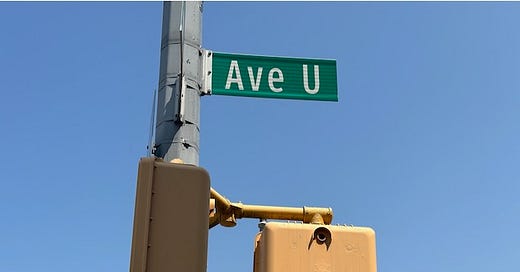





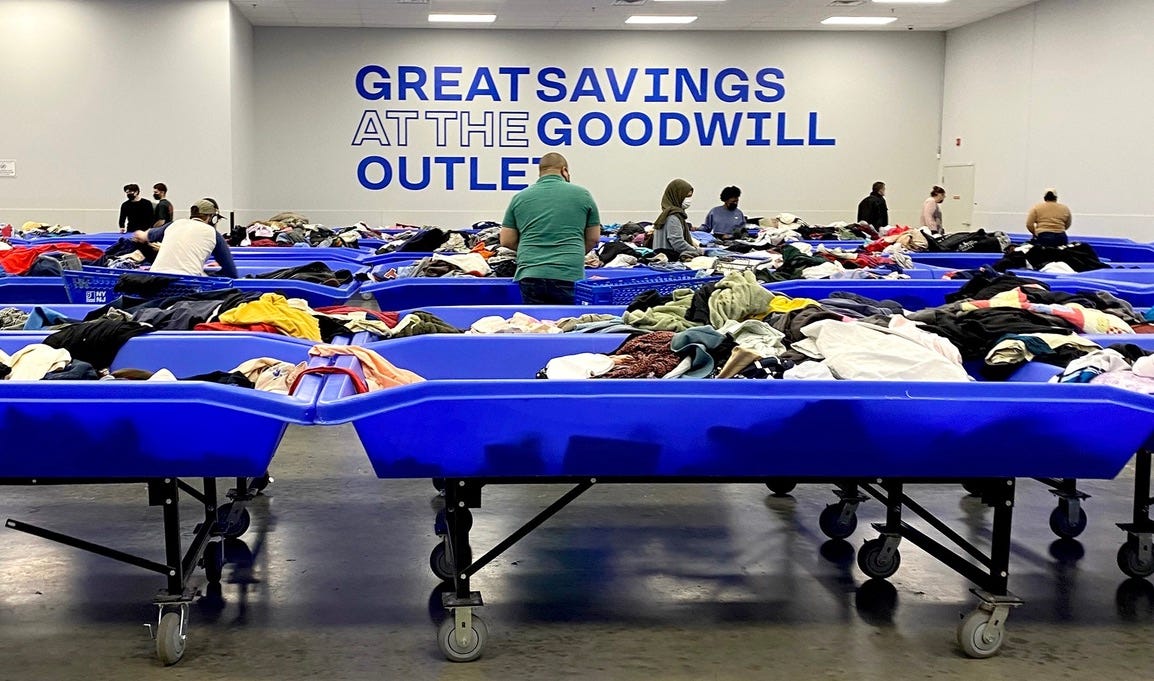


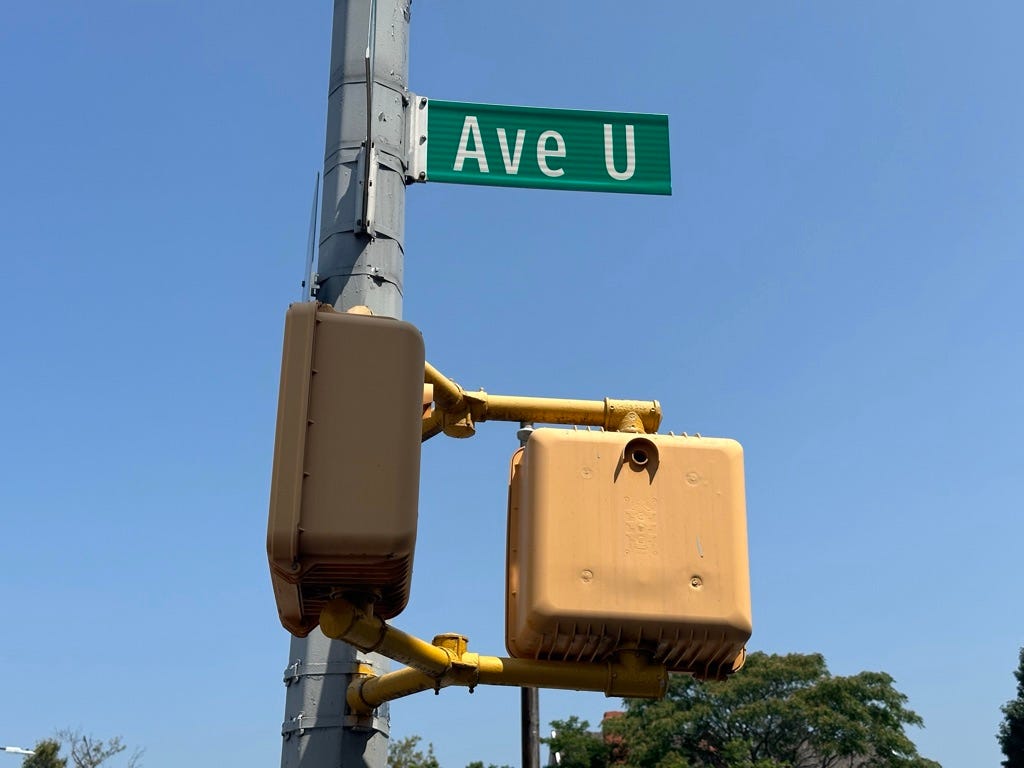


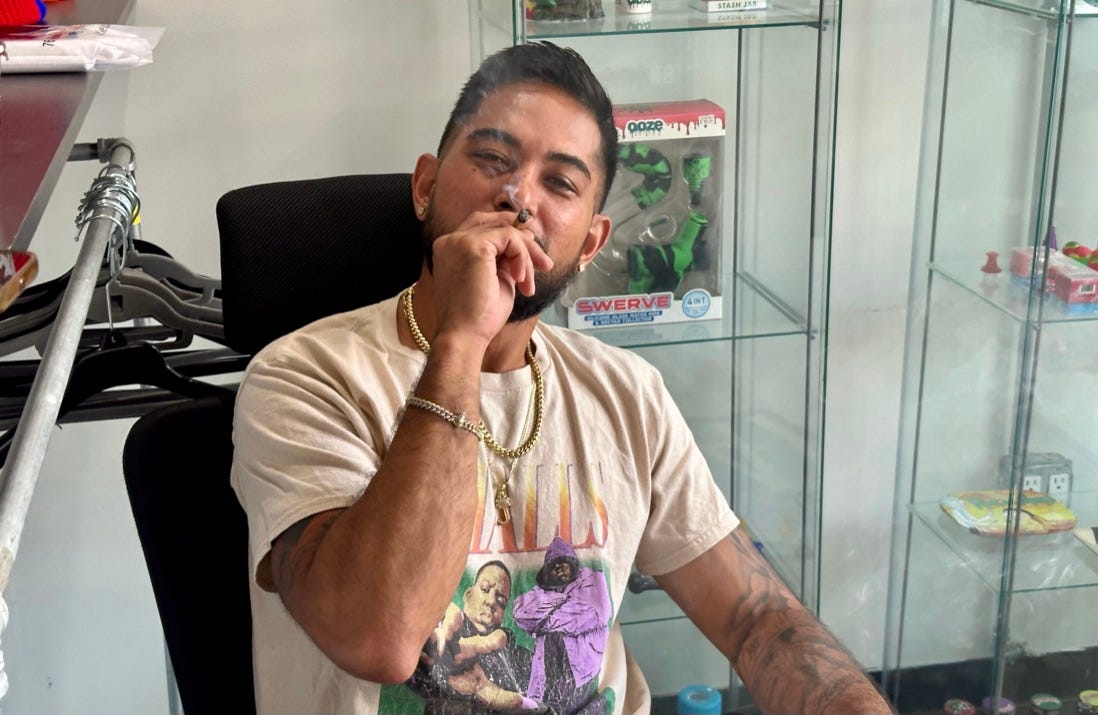


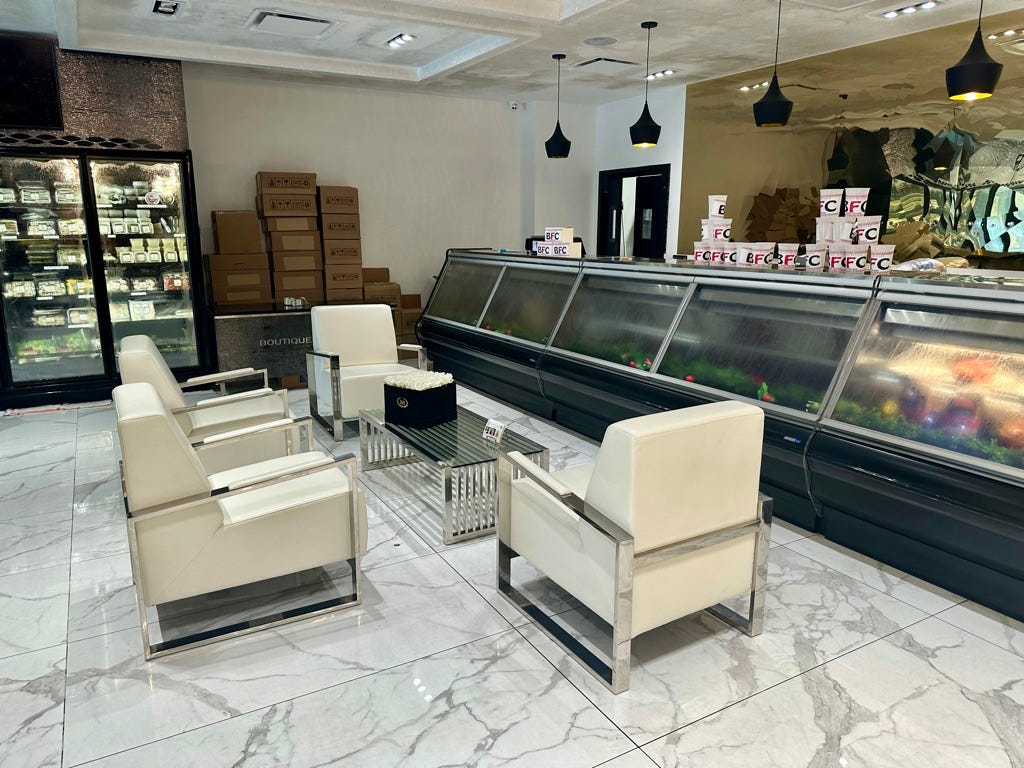

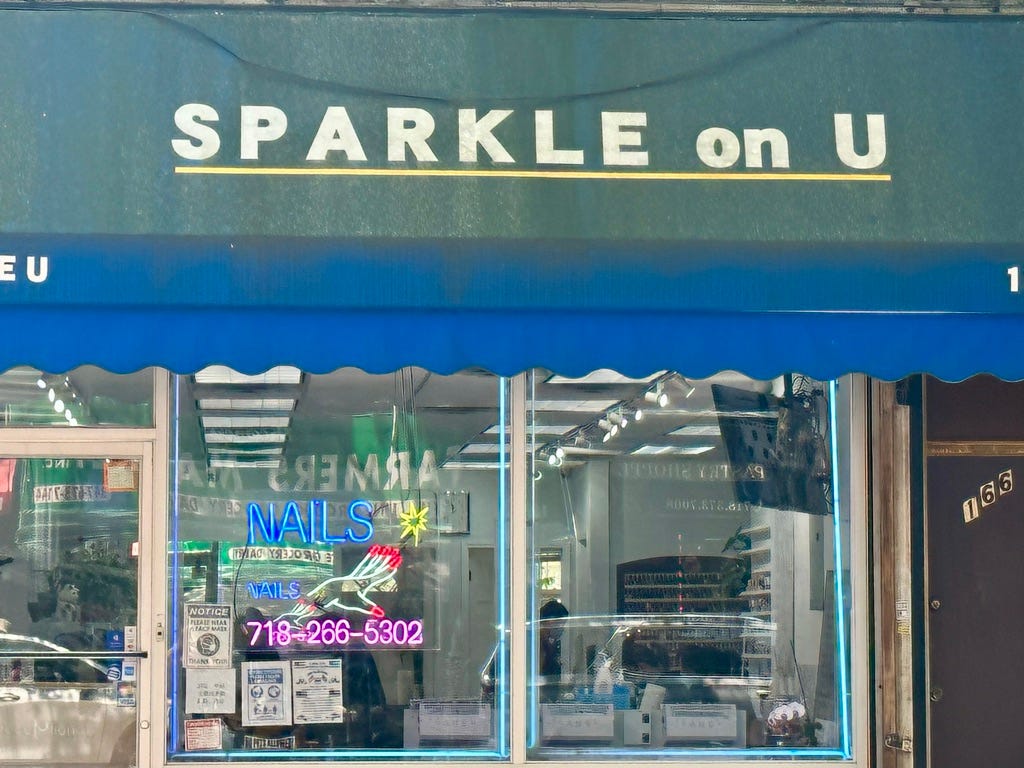





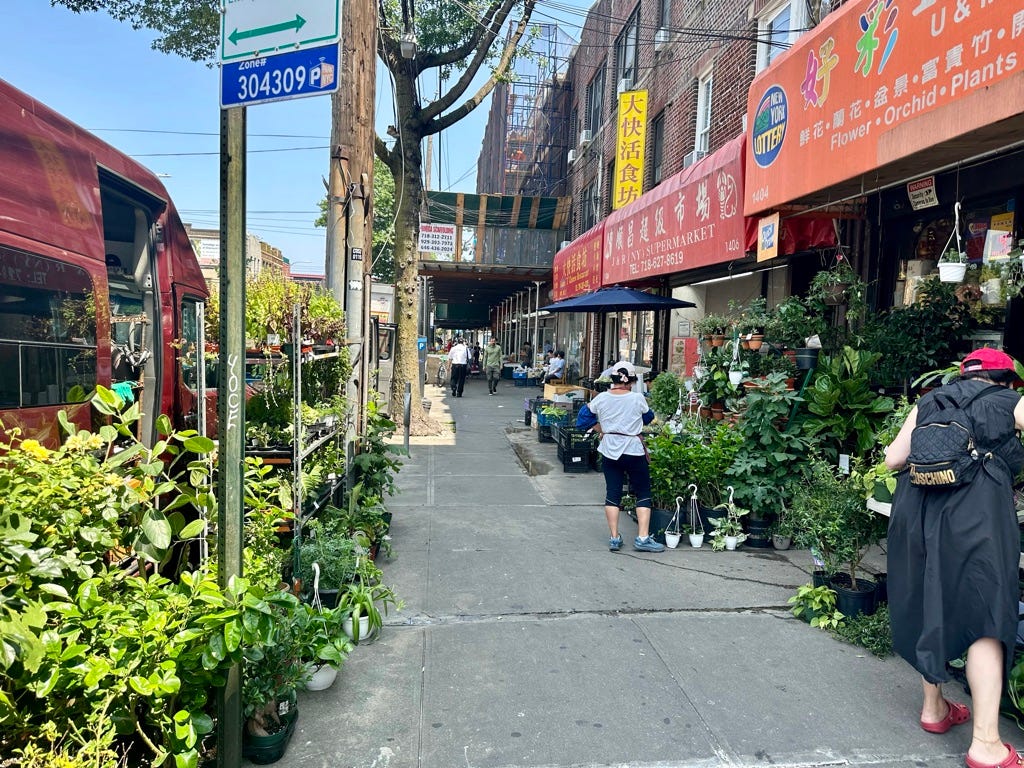




Anne, I was first completely fascinated with why on earth anyone, even you, would be interested in spending ANY time on Avenue U. I ran away from these neighborhoods in 1994 and swore never to return, for every reason you seemed to actually enjoy. The only cool thing to have ever landed on Avenue U was Groove Records waaaaaaay back in the day. It was one of NYC's very first shops/labels dedicated to techno, run by a bunch of now-legendary Brooklyn DJs. I don't know how South Brooklyn managed to produce anything that cool, but yea it had an insane techno scene in the early 90s.
But, that fascination quickly gave way to my fascination with the name "CMOLOVAR". It made absolutely no sense, yet just couldn't be that non-sensical, so I had to Google the storefront. Of course you were the only actual English speaker! They named that joint in a combination of Cyrillic and Roman letters that anyone other than for whom the place is intended would find unpronounceable. It is meant to read "Stolovaya" and translates into something like "Eatery".
PS: USSR didn't have Sweet’N Lo, so your Soviet vibe was a bit off-base. And to your question of: "Is this really like the food they would have eaten in the Soviet Union?" — NO! NO! NO! No one sane in the Soviet Union ate at restaurants unless it was some posh celebration-type joint where you paid them off well to put real food on the table. Restaurant food was considered inedible for most people used to home-cooking. I remember maybe 2 or 3 times eating out as a kid when we were traveling and had no choice.
Oppenheimer was a family movie for me. Both my mother and my father worked for the Manhattan Project, and my home life was filled with visits from and to Manhattan Project sites and people. George Kistiakowsky appeared in the film, and the night Martin Luther King Jr was assassinated, Kistiakowski was at our house for dinner. My heart was in my mouth for the entire three hours, but my husband and I are opera nerds. Three hours is NOTHING. We love Wagner, and Die Meistersinger von Nuremberg is 5 1/2 hours, which FLIES by.